Frogger II: Threeedeep!
 The Game: Frogger’s back, and he needs your help to do so much more than just cross the road. First, help Frogger navigate an assortment of underwater dangers to reach the safety of a log at the water’s surface, and then help him hop across the backs of various animals and objects to cross the river. Once this is accomplished, you help Frogger ascend to heaven…and then the whole process starts once more. (Parker Brothers, 1984)
The Game: Frogger’s back, and he needs your help to do so much more than just cross the road. First, help Frogger navigate an assortment of underwater dangers to reach the safety of a log at the water’s surface, and then help him hop across the backs of various animals and objects to cross the river. Once this is accomplished, you help Frogger ascend to heaven…and then the whole process starts once more. (Parker Brothers, 1984)
Memories: Officially authorized by Sega (while Sega was still authorized by Konami as the American distributor of the original Frogger), Frogger II: Threeedeep! is a sequel to the hit arcade game – a sequel that never made it into the arcades itself.
Track & Field
 The Game: It’s time for the 1984 Olympics! Qualify and compete in such events as the 100-meter dash, the long jump, javelin throw, and the shot-put. (Atari, 1984)
The Game: It’s time for the 1984 Olympics! Qualify and compete in such events as the 100-meter dash, the long jump, javelin throw, and the shot-put. (Atari, 1984)
Memories: In many cases, Atari faced a major obstacle in licensing major arcade games: the time and money required to secure the license (if it wasn’t already part of an overall deal), and the fact that by skipping the licensing process, Activision or Imagic would virtually always get there first with a more visually pleasing and playable product. But this time, Activision’s sheer speed helped Atari out: The Activision Decathlon practically did some of the R&D for Atari.
Tapper
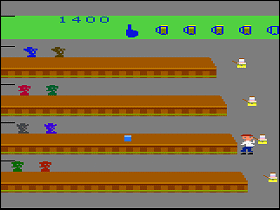 The Game: As a beleaguered bartender, you have to serve drinks to an endless onslaught of bar patrons, never allowing them to reach the end of the bar. You must also pick up empty glasses as they slide back toward you, and you can also grab a tip whenever one briefly appears. Clearing the screen of all pixellated hardened drinkers – erm, sorry, soft drinkers – takes you to the next screen, and other scenarios, including outdoor sporting events. (Bally/Midway-Sega, 1984)
The Game: As a beleaguered bartender, you have to serve drinks to an endless onslaught of bar patrons, never allowing them to reach the end of the bar. You must also pick up empty glasses as they slide back toward you, and you can also grab a tip whenever one briefly appears. Clearing the screen of all pixellated hardened drinkers – erm, sorry, soft drinkers – takes you to the next screen, and other scenarios, including outdoor sporting events. (Bally/Midway-Sega, 1984)
Memories: When the U.S. video game industry fell on hard times, Sega sold off its American division to Bally/Midway. Having previously tried to maintain more direct control of home versions of its arcade games through an overall licensing deal with CBS Electronics‘ game division, Bally/Midway now had a more direct pipeline to the consumer market by using the home video game division that Sega had launched to exploit its own arcade titles (such as Buck Rogers: Planet Of Zoom and Congo Bongo).
Star Trek: Strategic Operations Simulator
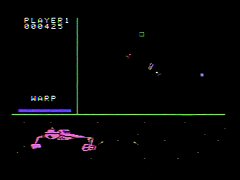 The Game: Welcome aboard, Captain. Your mission is to travel from sector to sector, eliminating Klingon incursions into Federation space without getting your Constitution-class starship and her crew destroyed. Friendly starbases offer aid and allow you to make resupply stops so you can keep up the good fight – and you do have to keep a careful eye on your phaser, shield and warp power. Periodically you’ll even have to navigate a minefield laid by the murderous Nomad probe while trying to catch a fleeting glimpse of Nomad itself so you can destroy it. (Coleco [under license from Sega], 1984)
The Game: Welcome aboard, Captain. Your mission is to travel from sector to sector, eliminating Klingon incursions into Federation space without getting your Constitution-class starship and her crew destroyed. Friendly starbases offer aid and allow you to make resupply stops so you can keep up the good fight – and you do have to keep a careful eye on your phaser, shield and warp power. Periodically you’ll even have to navigate a minefield laid by the murderous Nomad probe while trying to catch a fleeting glimpse of Nomad itself so you can destroy it. (Coleco [under license from Sega], 1984)
Memories: One of the better home versions of Sega’s vector arcade game, the ColecoVision edition of Strategic Operations Simulator pulls off the neat trick of very nearly delivering more authentic Star Trek atmosphere than its inspiration. Each game kicks off with the familiar strains of Alexander Courage’s opening fanfare for the Enterprise (replacing the rather non-specific opening music of the arcade game), and even the game-ending “simulation complete” message is accompanied by another passage from the Star Trek theme.
River Raid
 The Game: You’re piloting a fighter jet on a canyon run through enemy territory. You can’t fly outside the canyon walls, so stay over the river and blast everything in sight. Well, almost everything – flying your plane on top of “FUEL” buoys instead of shooting them puts a little bit of gas in the tank, and if you run out of fuel, you might as well just swallow the next enemy bullet, because you’re goin’ down. (Activision, 1984)
The Game: You’re piloting a fighter jet on a canyon run through enemy territory. You can’t fly outside the canyon walls, so stay over the river and blast everything in sight. Well, almost everything – flying your plane on top of “FUEL” buoys instead of shooting them puts a little bit of gas in the tank, and if you run out of fuel, you might as well just swallow the next enemy bullet, because you’re goin’ down. (Activision, 1984)
Memories: A dandy upgrade from the Atari 2600 River Raid, the Colecovision edition plays much the same. There are some audiovisual improvements, but it’s also surprising to see what’s been left alone in the graphics department too: these elements of the game weren’t broken, so there are no “fixes” for their own sake.
Q*Bert’s Qubes
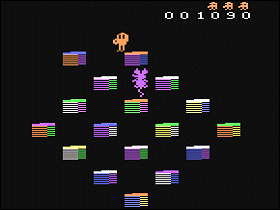 The Game: Q*Bert is back, hopping around from cube to cube, rotating the cubes 90 degrees with every hop…but a nasty bouncing rat and his minions are out to get the big Q. If one of the rat’s henchmen hops onto a cube whose top surface is the same color as its skin, it melts into the cube harmlessly. Q*Bert must change at See the videoleast one row of cubes to the target color to advance to the next level – and there aren’t any flying discs this time! (Parker Brothers, 1984)
The Game: Q*Bert is back, hopping around from cube to cube, rotating the cubes 90 degrees with every hop…but a nasty bouncing rat and his minions are out to get the big Q. If one of the rat’s henchmen hops onto a cube whose top surface is the same color as its skin, it melts into the cube harmlessly. Q*Bert must change at See the videoleast one row of cubes to the target color to advance to the next level – and there aren’t any flying discs this time! (Parker Brothers, 1984)
Memories: Thanks to a quirk of distribution more than anything, Q*Bert’s Qubes is one of the rarest and most valuable games for the Atari 2600. In the post-crash world of unhealable deep-cut discounts, some retailers decided to get out of the video game “fad” as soon as they could possibly get out from under the inventory. As a result, the final few Parker Brothers game cartridges wound up being sold almost exclusively through Sears. (As the retail chain that invested heavily in such products as Atari’s original home Pong console, Sears had more of a stomach for staying with the video game industry than most, but even then they balked a bit as the Atari gravy train went off the rails.)
Jr. Pac-Man
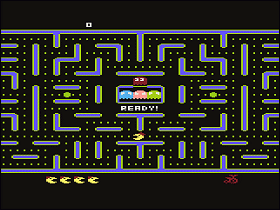
 The Game: As the offspring of a round yellow creature consisting of a mouth and nothing else, you maneuver around a bigger maze than your parents ever had to deal with, gobbling small dots and evading four colorful monsters who can eat you on contact. Six large flashing dots in the maze enable you to turn the tables and eat the monsters for a brief period. Periodically, assorted toys will begin hopping through the maze, turning every uneaten dot they touch into a larger dot which yields more points, but also forces little Pac to slow down to digest them. The monsters, once eaten, return to their home base in ghost form and return to chase you anew. If cleared of dots, the maze refills and the game starts again, but just a little bit faster… (Atari, 1984; released by AtariAge.com, 2003)
The Game: As the offspring of a round yellow creature consisting of a mouth and nothing else, you maneuver around a bigger maze than your parents ever had to deal with, gobbling small dots and evading four colorful monsters who can eat you on contact. Six large flashing dots in the maze enable you to turn the tables and eat the monsters for a brief period. Periodically, assorted toys will begin hopping through the maze, turning every uneaten dot they touch into a larger dot which yields more points, but also forces little Pac to slow down to digest them. The monsters, once eaten, return to their home base in ghost form and return to chase you anew. If cleared of dots, the maze refills and the game starts again, but just a little bit faster… (Atari, 1984; released by AtariAge.com, 2003)
Memories: A victim of former Commodore executive Jack Tramiel’s takeover of Atari‘s home video game and computer division, Jr. Pac-Man was one of the many “orphaned” games that were finished and ready for mass-production, but despite the money that had been spent on acquiring the license and developing the actual software, Jr. Pac-Man stayed off the schedule, never to hit the stores.
Ghostbusters
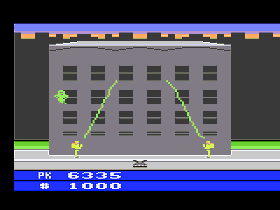 The Game: The only video game in history that turns you into Bill Murray, Ghostbusters gives you a taste of the lucrative franchising opportunity that is supernatural paranormal investigation and elimination. You start the game out with a supply screen and – naturally – a limited budget. Pick up all the ghostbusting gear you can afford and get to work. Much of the game is played out on a map of several city blocks of the Big Apple, where haunted buildings will flash red. You respond to each call by going there, which takes you to a brief “driving” game in which you can vacuum up free-roaming ghosts (if you’ve installed a ghost-vac on your car). Once you arrive, set the trap and position your two busters carefully (so as not to cross the streams), and snag the ghost before it simply leaves or slimes you. Trapping ghosts will net the big bucks, which you need to continue your franchise. Letting the paranormal activity in New Your City continue unabated will result in the unleashing of the Sta-Puft Marshmallow Man, who’ll stomp entire city blocks (and earn you a hefty fine). If the city’s PK (psychokinetic) activity meter reaches 10,000, the game is over. (Activision, 1984)
The Game: The only video game in history that turns you into Bill Murray, Ghostbusters gives you a taste of the lucrative franchising opportunity that is supernatural paranormal investigation and elimination. You start the game out with a supply screen and – naturally – a limited budget. Pick up all the ghostbusting gear you can afford and get to work. Much of the game is played out on a map of several city blocks of the Big Apple, where haunted buildings will flash red. You respond to each call by going there, which takes you to a brief “driving” game in which you can vacuum up free-roaming ghosts (if you’ve installed a ghost-vac on your car). Once you arrive, set the trap and position your two busters carefully (so as not to cross the streams), and snag the ghost before it simply leaves or slimes you. Trapping ghosts will net the big bucks, which you need to continue your franchise. Letting the paranormal activity in New Your City continue unabated will result in the unleashing of the Sta-Puft Marshmallow Man, who’ll stomp entire city blocks (and earn you a hefty fine). If the city’s PK (psychokinetic) activity meter reaches 10,000, the game is over. (Activision, 1984)
Memories: An addictive little game, this, and probably one of the best movie-to-video-game licenses ever brought to life. Ghostbusters on the big screen was big money when this game was released, and Activision had to deliver a decent game.
Frenzy
 The Game: You’re back in the maze, but this time, the stakes are increased, the danger is increased, and your strategic options are only slightly increased. Touching the walls, the robots, the robots’ laser blasts, or even your own ricocheted lasers are deadly. And of course, the inevitable appearance by Evil Otto is also deadly. However, you can temporarily repel the smiley little bugger by blasting him until his grin turns into the frown – but he will reappear mere seconds later, moving much faster every time he must retreat and reappear – so you’re not doing yourself any favors. If you enter a generator room, you can halt all the robots in their tracks by penetrating the walls surrounding the generator and blasting it. “Beaded” walls can be eaten away, bit by bit, by laser fire from anyone who shoots it, while solid walls will ricochet lasers around until they hit something – which could mean a death trap for you. (Coleco, 1984)
The Game: You’re back in the maze, but this time, the stakes are increased, the danger is increased, and your strategic options are only slightly increased. Touching the walls, the robots, the robots’ laser blasts, or even your own ricocheted lasers are deadly. And of course, the inevitable appearance by Evil Otto is also deadly. However, you can temporarily repel the smiley little bugger by blasting him until his grin turns into the frown – but he will reappear mere seconds later, moving much faster every time he must retreat and reappear – so you’re not doing yourself any favors. If you enter a generator room, you can halt all the robots in their tracks by penetrating the walls surrounding the generator and blasting it. “Beaded” walls can be eaten away, bit by bit, by laser fire from anyone who shoots it, while solid walls will ricochet lasers around until they hit something – which could mean a death trap for you. (Coleco, 1984)
Memories: It’s a bit of a rarity for an arcade manufacturer to license a sequel game to a different company than licensed the original, yet it happened in a handful of cases. Atari had licensed the arcade hit Berzerk and turned it into a near-perfect cartridge for the VCS, but when it came time to license the diabolically difficult follow-up for home video game play, it was Coleco who nabbed the rights.
Front Line
 The Game: You’re a lone footsoldier fighting your way through a platoon of enemy troops, trying to take out as many of them as you can until you find your way to a handy empty tank. But once you man your own tank, enemy tanks surround you. If one of them hits your tank, you have mere seconds to bail out before your tank blows, and you have to dodge cannon fire until you can find another friendly tank to commandeer. After crossing hazardous stretches of desert and fighting off entire battallions of enemy tanks, you’re en route to the final confrontation, a showdown with the enemy’s armored headquarters… (Coleco, 1984)
The Game: You’re a lone footsoldier fighting your way through a platoon of enemy troops, trying to take out as many of them as you can until you find your way to a handy empty tank. But once you man your own tank, enemy tanks surround you. If one of them hits your tank, you have mere seconds to bail out before your tank blows, and you have to dodge cannon fire until you can find another friendly tank to commandeer. After crossing hazardous stretches of desert and fighting off entire battallions of enemy tanks, you’re en route to the final confrontation, a showdown with the enemy’s armored headquarters… (Coleco, 1984)
Memories: At one time, this was one of my all-time favorite Atari 2600 games – well, it still is, actually – even though it really pales in comparison to the coin-op it’s based on. Even the version released for the ColecoVision, which used the roller wheel on the Super Action Controller to stand in for the arcade game’s aiming knob, wasn’t quite the same. Still, at the time, this did just fine: you fired your gun in whatever direction you were facing.
Congo Bongo
 The Game: Bongo the Ape sets your toes on fire while you’re asleep during a jungle expedition. So naturally, you drop everything to take revenge on the goofy gorilla. But first you have to reach him. The first level is a hazardous assortment of ramps and levels and a waterfall to jump across. Be careful of pesky little monkeys who can weigh you down so you move slower (and jump lower), and watch out for snakes. Then you have to hop across various islands and dodge more snakes as you try to get across a river. (Coleco [under license from Sega], 1984)
The Game: Bongo the Ape sets your toes on fire while you’re asleep during a jungle expedition. So naturally, you drop everything to take revenge on the goofy gorilla. But first you have to reach him. The first level is a hazardous assortment of ramps and levels and a waterfall to jump across. Be careful of pesky little monkeys who can weigh you down so you move slower (and jump lower), and watch out for snakes. Then you have to hop across various islands and dodge more snakes as you try to get across a river. (Coleco [under license from Sega], 1984)
Memories: Congo Bongo was one of those games that really tested the mettle of the next-generation consoles of the day. Sega’s own translation of the game for the Atari 2600 was a barely-playable mess, though the version released for the Atari 5200 was a marked improvement. But as with Zaxxon, its cousin from a visual-concept point of view, Congo Bongo didn’t really arrive at home until ported to the ColecoVision.
Cosmic Commuter
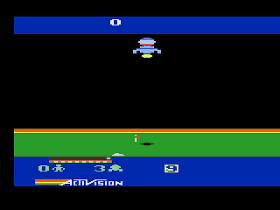 The Game: Sometimes it’s not all about saving the whole freakin’ world. Sometimes it’s about just being a cabbie. Picking people up, zipping through traffic, and trying to get them to where they’re going without them – or yourself – killed in the process. Substitute traffic for alien ships and space debris, and you’ve got Cosmic
The Game: Sometimes it’s not all about saving the whole freakin’ world. Sometimes it’s about just being a cabbie. Picking people up, zipping through traffic, and trying to get them to where they’re going without them – or yourself – killed in the process. Substitute traffic for alien ships and space debris, and you’ve got Cosmic  Commuter. Make sure your taxi pod is loaded up on fuel, avoid everything except for the passengers, and don’t forget to dock safely with your launch/landing module when you’ve picked everyone up. You can shoot obstacles out of your way in a tight squeeze, but be careful – you could also shoot your next refueling station out of the sky too. Three collisions or crash landings due to an empty gas tank, and you’re out of the taxi business. (Activision, 1984)
Commuter. Make sure your taxi pod is loaded up on fuel, avoid everything except for the passengers, and don’t forget to dock safely with your launch/landing module when you’ve picked everyone up. You can shoot obstacles out of your way in a tight squeeze, but be careful – you could also shoot your next refueling station out of the sky too. Three collisions or crash landings due to an empty gas tank, and you’re out of the taxi business. (Activision, 1984)
Memories: Cosmic Commuter is a very cool scrolling game with a neat premise, something that I can identify with a lot better than being a fighter jock. This is also an extremely colorful game with a heap of animated graphics, and not one second of sprite flicker.
Buck Rogers: Planet Of Zoom
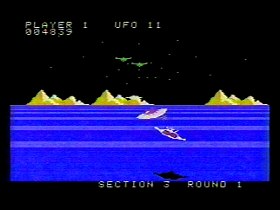 The Game: Zoom being the operative word here, your mission – as space hero Buck Rogers – is to fly in close quarters with all kinds of enemy ships, landers and structures, fending off their attacks, and generally staying alive as long as possible. Obligatory robot wisecracks and utterances of “beedy-beedy-beedy” not included. (Coleco [under license from Sega], 1984)
The Game: Zoom being the operative word here, your mission – as space hero Buck Rogers – is to fly in close quarters with all kinds of enemy ships, landers and structures, fending off their attacks, and generally staying alive as long as possible. Obligatory robot wisecracks and utterances of “beedy-beedy-beedy” not included. (Coleco [under license from Sega], 1984)
Memories: Far and away the most faithful home console version of Sega’s arcade sleeper hit, Buck Rogers: Planet Of Zoom is a blast on the ColecoVision.
Beamrider
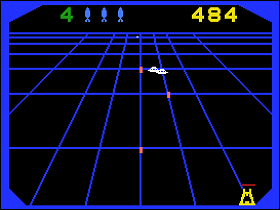 The Game: Alien ships are sliding toward you on a gridwork of energy; as the pilot of the Beamrider, your job is to destroy them before they get too close to home (i.e. the bottom of the screen). They can fire back, though, and while in some cases you can return fire and intercept their shots, it depends on what kind of weaponry they’re using. When you run out of Beamriders, the aliens take over. (Activision, 1984)
The Game: Alien ships are sliding toward you on a gridwork of energy; as the pilot of the Beamrider, your job is to destroy them before they get too close to home (i.e. the bottom of the screen). They can fire back, though, and while in some cases you can return fire and intercept their shots, it depends on what kind of weaponry they’re using. When you run out of Beamriders, the aliens take over. (Activision, 1984)
Memories: The Colecovision port of Activision‘s answer to Tempest, Beamrider is – perhaps not surprisingly – a lot smoother than it is on the Atari 2600. But somehow it manages to take its sweet time getting faster.
Beamrider

 The Game: Alien ships are sliding toward you on a gridwork of energy; as the pilot of the Beamrider, your job is to destroy them before they get too close to home (i.e. the bottom of the screen). They can fire back, though, and while in some cases you can return fire and intercept their shots, it depends on what kind of weaponry they’re using. When you run out of Beamriders, the aliens take over. (Activision, 1984)
The Game: Alien ships are sliding toward you on a gridwork of energy; as the pilot of the Beamrider, your job is to destroy them before they get too close to home (i.e. the bottom of the screen). They can fire back, though, and while in some cases you can return fire and intercept their shots, it depends on what kind of weaponry they’re using. When you run out of Beamriders, the aliens take over. (Activision, 1984)
Memories: With the abandoned 2600 prototype of Tempest being the closest thing to an exception, Beamrider was the only attempt to the bring that arcade game’s style of action to the 2600. And in the end, Beamrider more closely resembles the one-line idea that led to Tempest: “First Person Space Invaders“.
Ballblazer
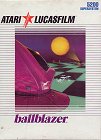 The Game: Pong just got a lot more difficult. The table-tennis-inspired sport is now played at blow-your-hair-back speeds on a 3-D field, with vehicles called rotofoils serving as the paddles. Up to four players can compete, or you can humiliate yourself by trying to fight computer-controlled opponents. (Atari/Lucasfilm Games, 1984)
The Game: Pong just got a lot more difficult. The table-tennis-inspired sport is now played at blow-your-hair-back speeds on a 3-D field, with vehicles called rotofoils serving as the paddles. Up to four players can compete, or you can humiliate yourself by trying to fight computer-controlled opponents. (Atari/Lucasfilm Games, 1984)
Memories: The announcement was simple, and ominous, and got a lot of press. “Lucasfilm is entering the video game industry.” It made big waves, and why wouldn’t it? The thought of someone with the tremendous creative resources of George Lucas getting in on the action was enough to excite many gamers – particularly those who, around 1984, were deluged in the kind of mediocre titles which brought the video game business to its knees.
Vulgus

 The Game: Piloting a lone space fighter, you carve a leisurely path through an endless onslaught of alien marauders, none of whom seem to be in any particular hurry to go anywhere either. Despite all this lack of hustle and bustle, however, it must be noted that they’re still shooting at you, and you still need to shoot back, using lasers or a limited supply of missiles. Some aliens will line up in a vertical formation that, if taken out with a missile, means big points, though you should also be saving some of your heavy ammo for larger alien ships that, if lasers were used, would require several shots to kill. (Capcom, 1984)
The Game: Piloting a lone space fighter, you carve a leisurely path through an endless onslaught of alien marauders, none of whom seem to be in any particular hurry to go anywhere either. Despite all this lack of hustle and bustle, however, it must be noted that they’re still shooting at you, and you still need to shoot back, using lasers or a limited supply of missiles. Some aliens will line up in a vertical formation that, if taken out with a missile, means big points, though you should also be saving some of your heavy ammo for larger alien ships that, if lasers were used, would require several shots to kill. (Capcom, 1984)
Memories: Another of Capcom’s long line of vertical-scrolling shooters – a design craze that can be traced back to Namco’s Xevious – Vulgus may seem like it’s terribly leisurely, but it’s actually one of the most grueling hand-eye coordination challenges since Robotron.
Time Pilot ’84
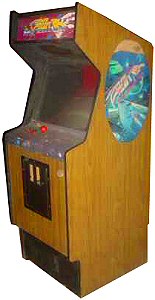 The Game: You’re back in the hotseat as the Time Pilot, but this time an even more fearsome breed of ships from the future is after you. The good news is that you have a new weapon at your disposal – guided missiles – but the bad news is that the enemy has them too. Blast enough enemy planes out of the sky and lure their command ship out of hiding; if you can survive long enough to blow the missile-spewing command ship to pieces, you’re off to the next level. (Konami, 1984)
The Game: You’re back in the hotseat as the Time Pilot, but this time an even more fearsome breed of ships from the future is after you. The good news is that you have a new weapon at your disposal – guided missiles – but the bad news is that the enemy has them too. Blast enough enemy planes out of the sky and lure their command ship out of hiding; if you can survive long enough to blow the missile-spewing command ship to pieces, you’re off to the next level. (Konami, 1984)
Memories: Bearing the deliciously Engrish-esque subtitle “Further into unknown world,” Time Pilot ’84 is a re-interpretation of the original game, with a few more bells and whistles in both the audiovisual and game play departments. Those accustomed to just constantly blasting away with both barrels in the original Time Pilot have to adjust to the proper use of the missile guidance system (don’t waste a missile until your screen paints a viable target), but other than that, it’s the same game with a new coat of paint.
Timber
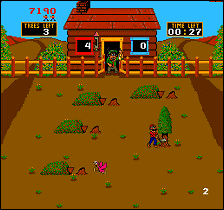 The Game: You’re a lumberjack and you’re okay. Your job is to chop down every tree that grows on the screen, without letting the trees fall on you. Birds are sometime dislodged from their nests as you chop down the trees, and they can be collected for additional points. Bears show up and throw beehives at you, which a lucky swing of the axe can destroy before they do any harm, but it’s altogether more likely that, unless dodged, a beehive will knock your lumberjack over and release a swarm of bees with their own sting operation in mind. You advance to the next level by clearing all of the trees in the time alotted; doing so with time to spare earns a bonus from the big boss; occasional bonus screens challenge you to keep your lumberjack from falling off a rolling log. (Midway, 1984)
The Game: You’re a lumberjack and you’re okay. Your job is to chop down every tree that grows on the screen, without letting the trees fall on you. Birds are sometime dislodged from their nests as you chop down the trees, and they can be collected for additional points. Bears show up and throw beehives at you, which a lucky swing of the axe can destroy before they do any harm, but it’s altogether more likely that, unless dodged, a beehive will knock your lumberjack over and release a swarm of bees with their own sting operation in mind. You advance to the next level by clearing all of the trees in the time alotted; doing so with time to spare earns a bonus from the big boss; occasional bonus screens challenge you to keep your lumberjack from falling off a rolling log. (Midway, 1984)
Memories: One of those offbeat gems that emerged in the ’80s with Midway’s relatively powerful new MCR (Midway Cart Rack) architecture, Timber is a quirky little game that has the unusual advantage of being nothing like any game that preceded it. (It’s hard to think of another game like it that came afterward, for that matter.)
Super Xevious
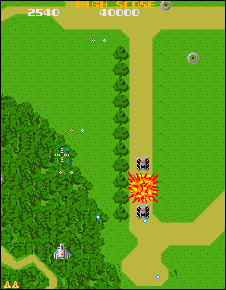 The Game: As the commander of a sleek Solvalou fighter, you’re deep into enemy territory, shooting their disc-shaped fighters out of the sky, bombing ground installations and artillery nests, bombing tanks, and trying to destroy the mothership. As you progress further behind enemy lines, heavier aircraft and more versatile and Buy this gamedeadly ground-based defenses become the norm. Also look out for tumbling airborne mirrors – they’re impervious to your fire, but you’re toast if you fly right into them. (Atari [under license from Namco], 1984)
The Game: As the commander of a sleek Solvalou fighter, you’re deep into enemy territory, shooting their disc-shaped fighters out of the sky, bombing ground installations and artillery nests, bombing tanks, and trying to destroy the mothership. As you progress further behind enemy lines, heavier aircraft and more versatile and Buy this gamedeadly ground-based defenses become the norm. Also look out for tumbling airborne mirrors – they’re impervious to your fire, but you’re toast if you fly right into them. (Atari [under license from Namco], 1984)
Memories: The original arcade Xevious was no pushover, but like several of its Namco stablemates, it was possible to outwit the machine by using some of its own pattern-based programming against it. With Super Xevious, this was more difficult, because the game’s internal A.I. was adaptive and could throw more at the player based on his demonstrated skill level. But some players had discovered a solution to this adaptive enemy intelligence, and games lasting more than ten minutes on a single quarter were not uncommon.
Return Of The Jedi
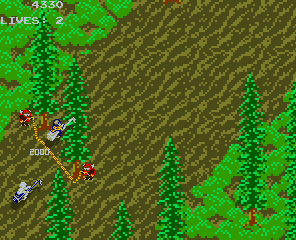
 The Game: In the first screen, you’re zipping through the forest of Endor on a stolen speeder bike, with Imperial stormtroopers on their own bikes chasing you. While you can shoot the stormtroopers’ bikes or bump them off the playing field, they can shoot you, and running into trees isn’t good for anyone’s health. Your only advantage? The indigenous Ewoks, those furry little critters who occupy a special, beloved place in every Star Wars fan’s heart, will help you out if you lead the stormtroopers into their primitive traps. The second screen is much like the first, only you’re flying the Millennium Falcon through the Death Star trenches, and the other speeder bikes are now TIE Interceptors. (Atari, 1984)
The Game: In the first screen, you’re zipping through the forest of Endor on a stolen speeder bike, with Imperial stormtroopers on their own bikes chasing you. While you can shoot the stormtroopers’ bikes or bump them off the playing field, they can shoot you, and running into trees isn’t good for anyone’s health. Your only advantage? The indigenous Ewoks, those furry little critters who occupy a special, beloved place in every Star Wars fan’s heart, will help you out if you lead the stormtroopers into their primitive traps. The second screen is much like the first, only you’re flying the Millennium Falcon through the Death Star trenches, and the other speeder bikes are now TIE Interceptors. (Atari, 1984)
The Game: Though graphically superior, and almost certainly guaranteed to gross more quarters just because of the Star Wars association, this game was, more or less, Zaxxon with a new paint job. Still, many players at the time hailed it as a vast step up from the vector graphics Star Wars game which Atari had released the previous year, even if the controls were aggravating.
Pirate Ship Higemaru
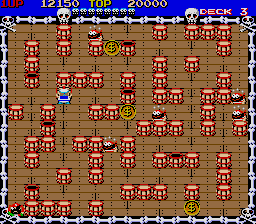 The Game: Pirates have boarded your ship, and it’s up to you to defend the whole boat. Evade the pirates in the twisty mazes of barrels and treasures in the cargo deck, or pick up one of those barrels and brain the nearest pirate with it. Be careful – some pirates hide inside the barrels, and it’s instant death to pick up an “occupied” barrel and not back off quickly. Some containers reveal a treasure when you pick them up, and you can go back and grab the treasures for bonus points. Clear the deck of pirates to advance to the next level and start again. (Capcom, 1984)
The Game: Pirates have boarded your ship, and it’s up to you to defend the whole boat. Evade the pirates in the twisty mazes of barrels and treasures in the cargo deck, or pick up one of those barrels and brain the nearest pirate with it. Be careful – some pirates hide inside the barrels, and it’s instant death to pick up an “occupied” barrel and not back off quickly. Some containers reveal a treasure when you pick them up, and you can go back and grab the treasures for bonus points. Clear the deck of pirates to advance to the next level and start again. (Capcom, 1984)
Memories: Not released in the United States, Pirate Ship Higemaru is a nice little riff on the basic concept of Pengo. You can move the components of the “maze”around as you wish, or use those same components to dispose of enemies. Since the procedure for doing this in Higemaru is a bit more complicated than Pengo, there’s actually a training round that must be completed before the game truly begins – but it’s not risk-free, and you can actually lose a life in training! (I guess the message is that if you can’t get past the training screen, please let someone else put a coin in the machine and defend the boat.)
Lode Runner
The Game: Cavernous rooms are loaded with gold, just ripe for the picking. But before you celebrate hitting the mother lode, look again – there are other gold-diggers homing in on the treasure. What do you have that they don’t? A drill gun that can blast a hole in the floors, into which your opponents will jump blindly. Eventually, the holes will reseal themselves, and that process will swallow your enemies (and you, if you happen to be clumsy enough to wander into the hole yourself). Grabbing all of the gold will reveal a passage to the next level of the game. (IREM [under license from Broderbund], 1984)
Memories: Lode Runner is right up there with the Ultima series and SimCity in my personal hall of fame of the coolest games ever to originate on any model of personal computer.
Circus Charlie
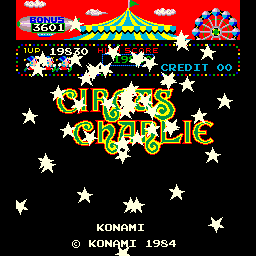
 The Game: As Charlie the circus clown, you undertake numerous hazardous activities to wow the big-top audience, including ridng a lion as he jumps through flaming hoops, walking a tightrope also inhabited by numerous monkeys over whom you must jump, leaping around on a series of trampolines (and hopefully over fire-breathers and knife-throwers who happen to be displaying their circus skills in an upward direction between trampolines), and finally a death-defying flying trapeze act. You only get three opportunities to strut your stuff, and then the show’s over. (Konami, 1984)
The Game: As Charlie the circus clown, you undertake numerous hazardous activities to wow the big-top audience, including ridng a lion as he jumps through flaming hoops, walking a tightrope also inhabited by numerous monkeys over whom you must jump, leaping around on a series of trampolines (and hopefully over fire-breathers and knife-throwers who happen to be displaying their circus skills in an upward direction between trampolines), and finally a death-defying flying trapeze act. You only get three opportunities to strut your stuff, and then the show’s over. (Konami, 1984)
It’s really like Track & Field with clown makeup, which in itself is somewhat disturbing. However you slice it, Circus Charlie is good clean fun, sort of the un-cola of sports games – there are a number of events (the game’s various “difficulty levels”), and the structure of the game is even the same, though here the action is confined to side-scrolling levels and it doesn’t feel like a sports game.
Buggy Challenge
 The Game: It’s a duel for dune buggy supremacy, and it won’t be easy. Drivers must contend not only with other drivers, but with dangerous terrain (sand hills that can launch a buggy into mid-air with little or no control over where it might land), killer obstacles including rocks and fence posts, and the amazing ease of losing all sense of direction. (Taito, 1984)
The Game: It’s a duel for dune buggy supremacy, and it won’t be easy. Drivers must contend not only with other drivers, but with dangerous terrain (sand hills that can launch a buggy into mid-air with little or no control over where it might land), killer obstacles including rocks and fence posts, and the amazing ease of losing all sense of direction. (Taito, 1984)
Memories: A fairly obscure first-person racer from Taito, Buggy Challenge is visually impressive, but in an era when it seemed like arcade game manufacturers were desperately trying to add complexity to control schemes – after all, a complex control scheme will probably get players “killed” more often, forcing more coin drop – Buggy Challenge most outstanding feature may be its blissful simplicity. There’s a gas pedal and a steering wheel. Try not to hit stuff that will cause the dune buggy to blow up. It really is that simple.
Xevious
 The Game: As the commander of a sleek Solvalou fighter, you’re deep into enemy territory, shooting their disc-shaped fighters out of the sky, bombing ground installations and artillery nests, bombing tanks, and trying to destroy the mothership. As you progress further behind enemy lines, heavier aircraft and more versatile and deadly ground-based defenses become the norm. Also look out for tumbling airborne mirrors – they’re impervious to your fire, but you’re toast if you fly right into them. (Atari, 1983)
The Game: As the commander of a sleek Solvalou fighter, you’re deep into enemy territory, shooting their disc-shaped fighters out of the sky, bombing ground installations and artillery nests, bombing tanks, and trying to destroy the mothership. As you progress further behind enemy lines, heavier aircraft and more versatile and deadly ground-based defenses become the norm. Also look out for tumbling airborne mirrors – they’re impervious to your fire, but you’re toast if you fly right into them. (Atari, 1983)
Memories: Based on a Namco import distributed under Atari’s banner in the U.S., Xevious may be about as close as one could get to replicating the arcade game with the 5200’s hardware. Curiously, though the copyright on the main menu screen is a year later than that on the unfinished 5200 Tempest proto, Xevious is a more complete game, fleshed out to a fully playable state.
UFO
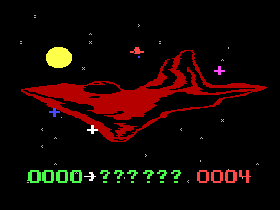 The Game: As the pilot of a lone space cruiser, you must try to clear the spaceways of a swarm of pesky and relatively harmless drone UFOs, but the job isn’t easy. You can ram the alien ships with your ship’s shields, destroying them (but forcing your shields offline for a few precious seconds during which anything could collide with your unprotected ship and destroy you), or shoot them (which also forces your shields down for a recharge). To that screenful of bite-sized chunks o’ death, add an unpredictable Killer UFO that likes to pop in and shoot at you, and suddenly being an interstellar traffic cop ain’t so easy. (Philips, 1983)
The Game: As the pilot of a lone space cruiser, you must try to clear the spaceways of a swarm of pesky and relatively harmless drone UFOs, but the job isn’t easy. You can ram the alien ships with your ship’s shields, destroying them (but forcing your shields offline for a few precious seconds during which anything could collide with your unprotected ship and destroy you), or shoot them (which also forces your shields down for a recharge). To that screenful of bite-sized chunks o’ death, add an unpredictable Killer UFO that likes to pop in and shoot at you, and suddenly being an interstellar traffic cop ain’t so easy. (Philips, 1983)
Memories: I’ve been complaining about the small library of Odyssey2-games-in-new-clothes developed as Odyssey3 launch titles quite a bit, but here’s a game I can actually get behind. UFO is the combination of a strong game in and of itself, with a background graphic that doesn’t completely obscure the in-game action.
Tutankham
 The Game: As an intrepid, pith-helmeted explorer, you’re exploring King Tut’s catacombs, which are populated by a variety of killer bugs, birds, and other nasties. You’re capable of firing left and right, but not vertically – so any oncoming threats from above or below must be outrun or avoided. Warp portals will instantly whisk you away to other parts of the maze (though this doesn’t necessarily mean safer). Gathering all of the treasures and keys will allow you to open the vault at the end of each level…which leads to the next, and even more difficult level. It’s like The Mummy, only much more entertaining. (Parker Brothers, 1983 – unreleased prototype)
The Game: As an intrepid, pith-helmeted explorer, you’re exploring King Tut’s catacombs, which are populated by a variety of killer bugs, birds, and other nasties. You’re capable of firing left and right, but not vertically – so any oncoming threats from above or below must be outrun or avoided. Warp portals will instantly whisk you away to other parts of the maze (though this doesn’t necessarily mean safer). Gathering all of the treasures and keys will allow you to open the vault at the end of each level…which leads to the next, and even more difficult level. It’s like The Mummy, only much more entertaining. (Parker Brothers, 1983 – unreleased prototype)
Memories: As far back as 1983, the year that it released four other titles for the Videopac (Europe’s equivalent to the Odyssey2), Parker Brothers had been mentioning other games in development for the system. The Videopac had a wider user base in Europe than the Odyssey2 had in North America, so the support was there. Spider-Man and Tutankham were announced as upcoming titles, and never surfaced as commercial releases. As it turns out, programming was relatively complete on both games, and the EPROM chips holding the work-in-progress versions of each game eventually fell in to the hands of collectors. Appropriately enough, Tutankham was an unearthed treasure.
Tempest
 The Game: As a strangely crablike creature, you scuttle along the rim of an abstract, hollow geometric tube, zapping red bow-tie-ish critters and purple diamond-shaped things which carry them. There are also swirly green things which spin “spikes” like webs, and by the way, you should avoid spikes. (Atari, 1983)
The Game: As a strangely crablike creature, you scuttle along the rim of an abstract, hollow geometric tube, zapping red bow-tie-ish critters and purple diamond-shaped things which carry them. There are also swirly green things which spin “spikes” like webs, and by the way, you should avoid spikes. (Atari, 1983)
Memories: The above description barely fits this game because it only exists in an unfinished form, with just a few bare essential elements of the game in place. You can shoot stuff and score points, but there isn’t much “game” there – the collision routines don’t exist that would determine whether or not your on-screen flipper “dies” by touching an approaching enemy, or an enemy’s incoming fire for that matter.
Spider-Man
 The Game: The Green Goblin and his henchmen are terrorizing the city once more, and it’s up to Spider-Man to restore order. But the odds are against him: he can only attach his web to the surface of the building, naturally, but the
The Game: The Green Goblin and his henchmen are terrorizing the city once more, and it’s up to Spider-Man to restore order. But the odds are against him: he can only attach his web to the surface of the building, naturally, but the  Goblin’s underlings are ready and eager to cut Spidey’s web should it be planted near them. Worse yet, the difficult-to-navigate high voltage tower at the top of the building is riddled with the Goblin’s bombs, and even if Spidey can defuse them, there’s a Super Bomb waiting for him at the top of the building – and he can only put it out of commission after dealing with the Green Goblin personally. (Parker Bros., 1983 / released by Bas Kornalijnslijper in 2006)
Goblin’s underlings are ready and eager to cut Spidey’s web should it be planted near them. Worse yet, the difficult-to-navigate high voltage tower at the top of the building is riddled with the Goblin’s bombs, and even if Spidey can defuse them, there’s a Super Bomb waiting for him at the top of the building – and he can only put it out of commission after dealing with the Green Goblin personally. (Parker Bros., 1983 / released by Bas Kornalijnslijper in 2006)
Memories: A chance discovery made by collector Bas Kornalijnslijper among a handful of ROM chips given to him by a former Phillips Electronics employee, Spider-Man was long known to have at least been in the works. Various advertising material touting the other four games created by Parker Bros. for the Videopac (the Odyssey2’s European near-twin) had mentioned that Spider-Man was “coming soon!” But of course, support for the Odyssey2 had largely disappeared by that time in North America (none of the Parker Bros. games were released there), and while it didn’t happen as quickly, the Videopac’s support also faded away in Europe; Spider-Man simply didn’t make it to market within that window. Now, along with another advertised-but-never-sold Parker Bros. title, Tutankham, Spider-Man has been unearthed.